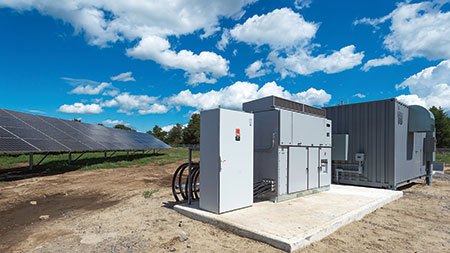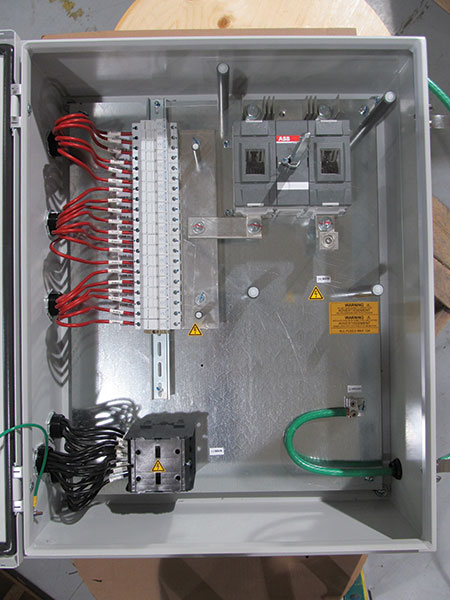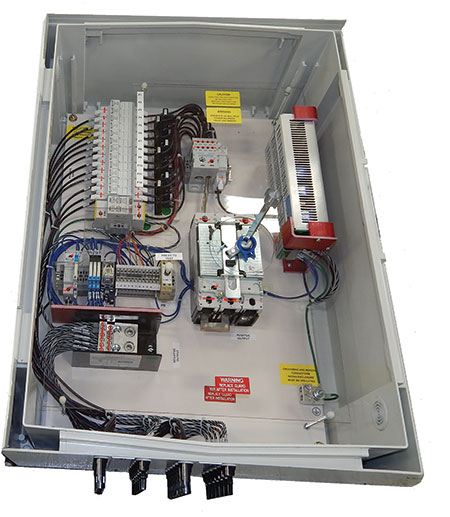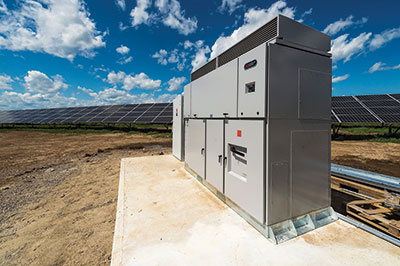A new safety standard in Canada for photovoltaic combiners has been developed known as CSA Standard C22.2 No 290 Photovoltaic Combiners. The 2015 Canadian Electrical Code Part I (CE Code) defines a photovoltaic combiner as:
“an assembly of buses and connections that may contain overcurrent protective devices, control apparatus, switches, or other equipment and that connects photovoltaic source circuits or the outputs of other combiners together to create an output at higher current or higher voltage, or both.”
The scope of this new CSA standard will cover combiners intended to be installed in nonhazardous locations on photovoltaic systems that could be ungrounded, positive grounded, and/or negative grounded with a maximum voltage rating up to 2000 V dc or 750 V ac. The voltage level of 2000 V dc was chosen to align with the maximum voltage ratings in other photovoltaic equipment standards like CSA Standard C22.2 No 271-11 Photovoltaic Cables.
This new standard is not intended to cover distribution equipment already covered in CSA standards C22.2 No. 29 Panelboards, C22.2 No. 31 Switchgear Assemblies, and C22.2 No. 244 Switchboards.

In addition to seven definitions that match existing definitions in the CE Code, this standard has added a note to the definition of photovoltaic combiner recognising recombiners as combiners whose inputs are provided from other combiners. This standard also added a new definition for combiner output circuit that reads “circuit conductors between the combiner(s) and the recombiner, power conditioning unit or direct-current utilization equipment.”
Similar to requirements in CSA Standard C22.2 No.29 for panelboards, the photovoltaic combiner standard covers enclosures, openings in enclosures, fastening and support for current-carrying parts, bus bars, wiring terminals, electrical spacings, overvoltage categories, surge suppression, pollution degree, wiring space, wire bending space, common connection bus bars, equipment bonding and switching devices.
Notable construction differences from requirements in CSA Standard C22.2 No.29 for panelboards are requirements for disconnection means, combiners rated for voltages greater than 750V (high voltage), separation of circuits, and conductor identification.

Disconnecting means
CE Code Rule 64-060(12) requires an output disconnecting means to be integral with or within 2M of each photovoltaic combiner and interlocking where fuses are used for the photovoltaic input circuits. This standard recognises the manufacturer’s option not to provide the output disconnect, but does mandate marking to indicate that a disconnect required by the CE Code will need to be field installed and interlocked as required.
High Voltage Combiners
High voltage combiners rated over 1000 V dc are required to have switches with visible isolation for all photovoltaic input and output circuits that are interlocked with doors giving access to high voltage fuses aligning with CE Code Rules 36-204, and 36-208.

Separation of Circuits
All conductors within the combiners are required to be rated for the highest voltage or are required to be segregated by barriers, routing, of grounded shielding.
Switching Devices
The switching devices clauses in the standards have two requirements; first, is to have the output device marked “OUTPUT” and no other switching device in the combiner shall be so marked, and second, is a requirement for those circuit breakers, fused switches, or a main terminal kit that use a friction or plug-on bus bar connection to be provided with a tie-down kit.
Conductor Identification
To align the conductor polarity identification requirements in Rule 64-212 of the CE Code, the standard requires insulated conductors to be red for positive, black for negative, or printing of “+/–”, “pos/neg” or “positive/negative” on the insulation or jacket that is repeated at a maximum of 300 mm intervals.
Marking Requirements
The permanent nameplate of photovoltaic combiners is required to be readily seen after installation without the use of a tool, and is required to include the following information:
a) the manufacturer’s identification
b) the catalogue or type number
c) serial numbers, or equivalent
d) maximum rated circuit voltage
e) dc, or ac frequency
f) the maximum continuous operating current rating of each of the input “photovoltaic source” or input “photovoltaic output” circuits
g) the maximum short-circuit current rating (SCCR) for each of the input “photovoltaic source” or input “photovoltaic output” circuits;
h) the maximum sum of the short-circuit current ratings of the input “photovoltaic source” circuits or input “photovoltaic output” circuits;
i) the maximum continuous operating current rating of the output “photovoltaic output” circuit;
j) for a combiner that does not incorporate an output overcurrent protective device,–the maximum allowed backfeed current, or the maximum rating or setting of the overcurrent protective device to be used in the installation to limit the back-feed current;
Note: The purpose of this requirement is to provide information to the installer —in order to properly limit the reverse current that can be fed back into the combiner under fault conditions.
k) “SUITABLE FOR PHOTOVOLTAIC USE” or equivalent; and
l) the type or types of system (ungrounded, positive grounded, negative grounded, bipolar, etc.) that the combiner is intended for use with.
In addition, the nameplate photovoltaic combiners are required to be marked with the type of overcurrent device to be used including the range of ampere ratings, and the interrupting rating.

Photovoltaic Combiner Testing
Testing for photovoltaic combiners is similar to testing for panelboards in CSA Standard C22.2 No 29 including, temperature testing, dielectric strength test, heat cycling test, flammability test, moisture absorption test, deflection test for metal enclosures, impact test for polymeric enclosures, and impulse testing.
Auxiliary equipment for photovoltaic combiner
The new standard also includes a section for auxiliary equipment for photovoltaic combiner. Auxiliary equipment could include metering, monitoring, temperature controls, ventilation, and control equipment.

Other CSA standards developed specifically for photovoltaic equipment are C22.2 No 271, Photovoltaic Cables, C22.2 No 304 Enclosed and dead-front switches for photovoltaic applications, C22.2 No 305 Molded case circuit breakers for use in photovoltaic systems, and C22.2 No 61730-1 Photovoltaic Module Safety Qualification — Part 1: Requirements for Construction, and C22.2 No 61730-2 Photovoltaic Module Safety Qualification — Part 2: Requirements for Testing, C22.2 No 62109-1 Safety of Power Converters for use in Photovoltaic Power Systems – Part 1: General Requirements, and C22.2 No 62109-1 Safety of Power Converters for use in Photovoltaic Power Systems – Part 2: Particular Requirements for Inverters.











Find Us on Socials